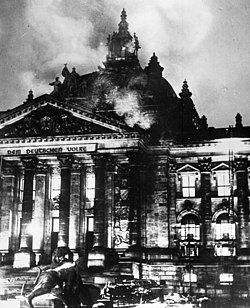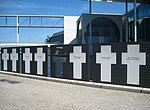Reichstag fire

The Reichstag fire (German: Reichstagsbrand, pronounced [ˈʁaɪçstaːksˌbʁant] ) was an arson attack on the Reichstag building, home of the German parliament in Berlin, on Monday, 27 February 1933, precisely four weeks after Adolf Hitler was sworn in as Chancellor of Germany. Marinus van der Lubbe, a Dutch council communist, was said to be the culprit; the Nazis attributed the fire to a group of Communist agitators, used it as a pretext to claim that Communists were plotting against the German government, and induced President Paul von Hindenburg to issue the Reichstag Fire Decree suspending civil liberties and pursue a "ruthless confrontation" with the Communists. This made the fire pivotal in the establishment of Nazi rule in Germany. The first report of the fire came shortly after 9:00 p.m., when a Berlin fire station received an alarm call. By the time police and firefighters arrived, the structure was engulfed in flames. The police conducted a thorough search inside the building and found Van der Lubbe, who was arrested. After the Fire Decree was issued, the police – now controlled by Hitler's Nazi Party – made mass arrests of communists, including all of the communist Reichstag delegates. This severely crippled communist participation in the 5 March elections. After the 5 March elections, the absence of the communists allowed the Nazi Party to expand their plurality in the Reichstag, greatly assisting the Nazi seizure of total power. On 9 March 1933 the Prussian state police arrested Bulgarians Georgi Dimitrov, Vasil Tanev, and Blagoy Popov, who were known Comintern operatives (though the police did not know it then, Dimitrov was head of all Comintern operations in Western Europe). Ernst Torgler, head of the Communist Party, had surrendered to police on 28 February. Van der Lubbe and the four communists were the defendants in a trial that started in September 1933. It ended in the acquittal of the four communists and the conviction of Van der Lubbe, who was then executed. In 2008, Germany posthumously pardoned Van der Lubbe under a law introduced in 1998 to lift unjust verdicts from the Nazi era. The responsibility for the Reichstag fire remains a topic of debate, as while Van der Lubbe was found guilty, it is unclear whether he acted alone. The consensus amongst historians is the Reichstag was set ablaze by Van der Lubbe; some consider it to have been a part of a Nazi plot, a view Richard J. Evans labels a conspiracy theory.
Excerpt from the Wikipedia article Reichstag fire (License: CC BY-SA 3.0, Authors, Images).Reichstag fire
Verwaltungsverband Oberes Renchtal
Geographical coordinates (GPS) Address Phone number Website Nearby Places Show on map
Geographical coordinates (GPS)
| Latitude | Longitude |
|---|---|
| N 52.518611111111 ° | E 13.376111111111 ° |
Address
Klosterhof Allerheiligen
6
77728 Verwaltungsverband Oberes Renchtal
Baden-Württemberg, Deutschland
Open on Google Maps











